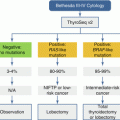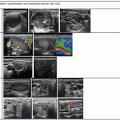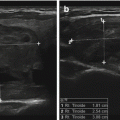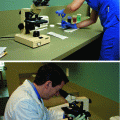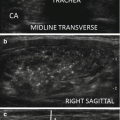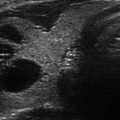© Springer International Publishing AG 2018
Daniel S. Duick, Robert A. Levine and Mark A. Lupo (eds.)Thyroid and Parathyroid Ultrasound and Ultrasound-Guided FNA https://doi.org/10.1007/978-3-319-67238-0_11. History of Thyroid Ultrasound
(1)
Geisel School of Medicine at Dartmouth College, Thyroid Center of New Hampshire, St. Joseph Hospital, Nashua, NH, USA
(2)
Jackson Thyroid & Endocrine Clinic, PLLC, Jackson, MS, USA
Keywords
HistoryA-modeB-modeSonarTherapeutic ultrasoundDiagnostic ultrasoundWater bathTransducerThyroid malignancyFine-needle aspiration biopsyDoppler ultrasoundAbbreviations
AACE
American Association of Clinical Endocrinologists
AIUM
American Institute of Ultrasound Medicine
ATA
American Thyroid Association
ECNU
Endocrine Certification in Neck Ultrasound
MHz
Megahertz
Introduction
The visual application of sound in medicine has revolutionized the diagnosis and management of thyroid disease. The safety of ultrasound, along with improvements in image quality and equipment availability, underlies the importance of thyroid ultrasound to today’s endocrinologist and endocrine surgeon.
The thyroid is amenable to ultrasound study because of its superficial location, vascularity, size, and echogenicity [1]. In addition, the thyroid has a very high incidence of nodular disease, the vast majority benign. Most structural abnormalities of the thyroid need evaluation and monitoring but may not require intervention [2]. Between 1965 and 1970, there were seven articles published specific to thyroid ultrasound. In the last 5 years, there have been over 10,000 articles published. Thyroid ultrasound has undergone a dramatic transformation from the cryptic deflections on an oscilloscope produced in A-mode scanning, to barely recognizable B-mode images, followed by initial low-resolution gray scale, to current high-resolution images. Recent advances in technology, including harmonic imaging, spatial compound imaging, elastography, and three-dimensional reconstruction, have all furthered the field.
The development of high-resolution thyroid ultrasound required decades of study in both the acoustics of sound and data processing. Some animals, for example, dolphins and bats, have the ability use ultrasound in their daily activities in everything from catching prey to finding a mate. As early as the 1700s, the Italian biologist Lazzaro Spallanzani demonstrated that bats use high frequency sound waves to navigate in complete darkness [3]. The aim of this chapter is provide an overview of the basic advancements in the field of ultrasound that have provided the ability to easily and safely see and interpret structures inside the neck.
Beginnings of Ultrasound History
One of the earliest experiments regarding transmission of sound was performed in 1826 in Lake Geneva by Jean-Daniel Colladon. Using an underwater bell he determined the speed of sound transmission in water. In the 1800s, properties of sound including wave transmission, propagation, reflection, and refraction were defined. In 1877 Lord Rayleigh’s English treatise, “Theory of Sound,” added mathematics and became the basis for the applied study of sound. The principles described lead to the science of using reflected sound in identifying and locating objects. In 1880, Pierre and Jacques Curie discovered the piezoelectric effect, determining that an electric current applied across a crystal would result in a vibration that would generate sound waves and that sound waves striking a crystal would, in turn, produce an electric voltage. Piezoelectric transducers were capable of producing sonic waves in the audible range and ultrasonic waves above the range of human hearing [3].
Sonar
The first patent for a sonar device was issued to Lewis Richardson, an English meteorologist, only 1 month after the Titanic sank following collision with an iceberg. The first functional sonar system was made in the United States, by Canadian Reginald Fessenden, in 1915. The Fessenden “fathometer ” could detect an iceberg 2 miles away. As electronics improved, Paul Langevin designed a device called a hydrophone. It became of the one of the first measures available to detect German U-Boats during World War I. The hydrophone was the basis of the pulse-echo sonar that is still employed in ultrasound equipment today [3, 4].
Rudimentary high frequency ultrasound analysis was used on a commercial basis in the 1930s and 1940s to detect defects in steel such as the hull of a ship. Although crude by today’s standards, inhomogeneity suggested abnormalities, whereas a flawless appearance suggested uniform material [4]. With the end of World War II, the development of the computer and the invention of the transistor advanced the development of medical ultrasound [3].
Early Medical Applications of Ultrasound
The initial use of ultrasound in medicine in the 1940s was therapeutic rather than diagnostic. Following the observation that very high-intensity sound waves had the ability to damage tissues, lower intensities were tried for therapeutic uses. Focused sound waves were used to mildly heat tissue for therapy of rheumatoid arthritis, and early attempts were made to destroy the basal ganglia to treat Parkinson’s disease [4]. The American Institute of Ultrasound in Medicine (AIUM) was formed in 1952 with therapeutic ultrasound in physical medicine being the primary focus. Although members performing diagnostic ultrasound were not accepted until 1964, diagnostic ultrasound is currently the primary focus of this organization [3].
Early in the twentieth century, Paul Langevin described the ability of high-intensity ultrasound to induce pain in a hand placed in a water tank. The 1940s saw therapeutic ultrasound tried in numerous applications ranging from gastric ulcers to arthritis. Attempts to destroy the basal ganglia in patients with Parkinson’s disease now seem archaic. At the time therapeutic ultrasound was headed toward the museum of medical quackery, consideration of ultrasound as a diagnostic tool in medicine had begun. Although Drs. Gohr and Wedekindt at the Medical University of Koln, Germany, suggested that ultrasound could detect tumors, exudates, and abscesses, the results were not convincing. Karl Theodore Dussik is credited as the first physician to use diagnostic ultrasound. In his 1952 report, “Hyperphonography of the Brain,” ultrasound was utilized in localizing brain tumors and the cerebral ventricles by transmitting ultrasonic sound through the skull. While the results of these studies were later discredited as predominantly artifact, this work played a significant role in stimulating research into the diagnostic capabilities of ultrasound [3].
A-Mode Ultrasound
One of the first studies of diagnostic ultrasound was performed by George Ludwig. Using A-mode ultrasound, his main focus was using ultrasound to detect gallstones, shown as reflected sound waves on an oscilloscope screen. Through his study of various tissues, including the use of live subjects, clinical utility of diagnostic ultrasound was described. Despite the limited efficacy of his rudimentary ultrasound system, Ludwig’s most important achievement may be his determination of the velocity of sound transmission in animal soft tissues. Ludwig also determined that the optimum frequency of an ultrasound transducer for deep tissue was between 1 and 2.5 MHz. The ultrasound characteristics of mammalian tissue were further defined by physicist Richard Bolt at Massachusetts Institute of Technology and neurosurgeon H. Thomas Ballantine, Jr. at Massachusetts General Hospital [3].
Most of early ultrasound used a transmission technique, but by the mid-1950s that was supplanted by a reflection technique. Providing information limited to a single dimension, A-mode scanning showed deflections on an oscilloscope indicating distance to reflective surfaces [4] (see Fig. 2.7). A-mode ultrasonography was used for detection of brain tumors, shifts in the midline structures of the brain, localization of foreign bodies in the eye, and detection of detached retinas [4]. In the first presage that ultrasound may assist in the detection of cancer, John Julian Wild reported the observation that gastric malignancies were more echogenic than normal gastric tissue. Along with Dr. John Reid, he later studied 117 breast nodules using a 15 MHz sound source and reported the ability to determine their size with an accuracy of 90% [3].
B-Mode Ultrasound
During the late 1950s, the first two-dimensional B-mode scanners were developed. B-mode scanners display a compilation of sequential A-mode images to create a two-dimensional image (see Fig. 2.8). Douglass Howry developed an immersion tank B-mode ultrasound system which was featured in the Medicine section of Life Magazine in September 1954 [3]. Several additional models of immersion tank scanners followed. All utilized a mechanically driven transducer that would sweep through an arc, with an image reconstructed to demonstrate the full sweep. Continued development led to the “Pan-scanner ,” a more advanced B-mode device, but it still employed a cumbersome bathtub of water. Later advances included a handheld transducer that still required a mechanical connection to the unit to provide data regarding location and water-bag coupling devices to eliminate the need for immersion [3].
By 1964, the work of Joseph H. Holmes along with William Wright and Ralph (Edward) Meyerdirk lead to the prototype of the “compound contact” scanner, with direct contact of the transducer with the patient’s body. As stated in a 1958 Lancet article describing ultrasound evaluation of abdominal masses, “Any new technique becomes more attractive if its clinical usefulness can be demonstrated without harm, indignity or discomfort to the patient” [5].
Stay updated, free articles. Join our Telegram channel

Full access? Get Clinical Tree


